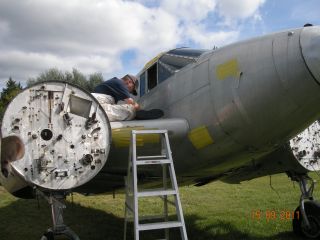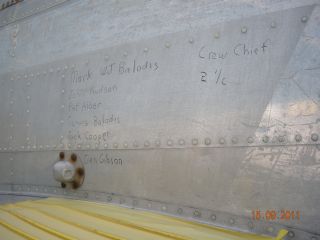Phase 5 Details

MRP Owasso
Purchasing of Parts
It’s getting harder and harder to find parts for the Beech 18 these days. Fortunately, Shelly Warren (at Southwestern Aero Exchange) opened her doors very briefly earlier this year, and I was able to purchase a number of essential B18 parts.
The big challenge was identifying the critical parts of the B18 that are essential to returning her to “Serviceable” status. (Another way of putting it is identifying the ‘nice to have’, versus the ‘need to have’.)
After purchasing them, I had them shipped. (I would have preferred to head down to Owasso to pick them up, but it turned out that it wasn’t possible.) As it stands now, the parts have been shipped close to where the airplane is located – which makes it easier to pick up the parts and store them properly.
MRP Redditt (12 – 16 SEP 2011)
Installation of Belly Panel
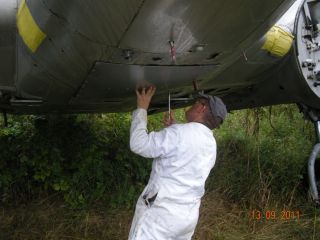
The belly panel was installed on this MRP to try and limit the amount of moisture that was getting into the airplane.
Removal of Parts from Rollie’s Aircraft
Upon examining Expeditor 339, it was noted that there were several parts that had been drilled off for spares. (In addition to that, it was noted that the fire Extinguisher Lines hadn’t even been installed.)
So, with permission from Rollie, Dad and I carefully drilled off the parts.
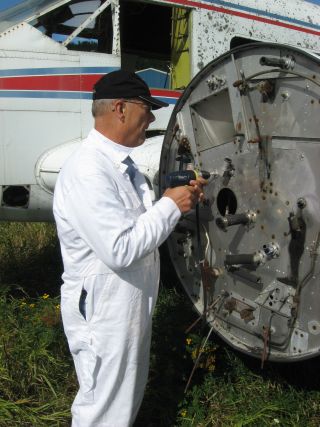
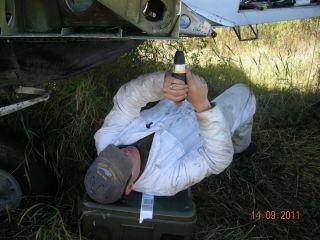
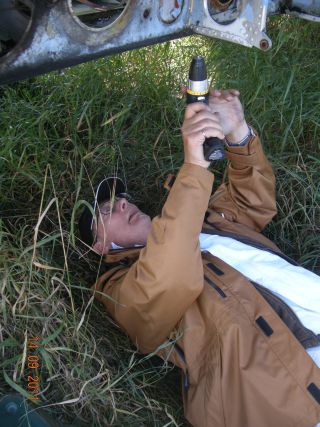
After two days of almost non-stop drilling, Dad and I had removed the parts in question – without damaging the parts or the aircraft in question. (We didn’t make one double hole.)
Installation of Tail Wheel
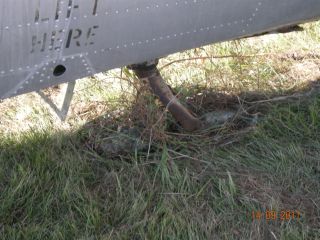
Here’s what the tail landing gear looked like right after Dad and I pulled her out from the spot where she’s been resting.
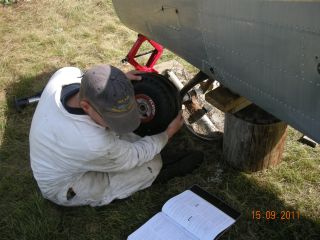
Right now, it’s in the process of changing out Tail Wheel Skid and installing the Tail Wheel.
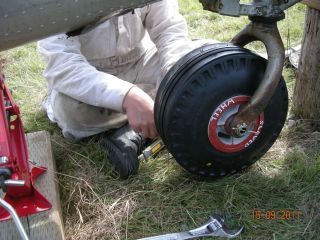
Right before the two cotter pins are installed.
Now, for the first time in a very long time, Expeditor 339 is now resting on three tires, and is now able to move around that much better.
The Origin of the Slaved Tail Wheel
The Tail Wheel Hub was purchased in 2008 through a contact, but there wasn’t any corresponding paperwork with it to show its cycles or its hours of flight.
The easiest thing to do would be to just install the Tail Wheel Hub and forget about it, but that wasn’t the approach that was done. (I’d much rather be honest about the component history of these parts.)
Instead, the Hub was taken to IMP and NDT’d and primed. After that, new bearings, races, new inner tube and tire were installed by Lake Central in Muskoka. (This way, the Tail Wheel Hub was in as good a shape as it was going to be – and it didn’t have to be worried about once it was installed.)
There’s a term that’s used in the RCAF when you’re installing a component that isn’t intended for flight, and that term is ‘slaved’. Now, there’s a way to visually identify that a part is ‘slaved’ – it has a red stripe on it and the word ‘slaved’ written on the red paint in white letters.
Now, the reason that the slaved Tail Wheel Hub was installed was to make it easier to move the airplane around on the ground – and make it easier to move the airplane closer to the main road. (This is critical for the following year, where the airplane will be moved to Muskoka Airport.)
Removal of Fuel and Oil Tanks
Next up was removing the Cowlings, the Fuel tanks, the Oil Tanks and the floorboards from inside the aircraft. (The idea being to move the parts to a more secure location – and to move them out of the weather.)

After a 21 hour drive back to Muskoka from Kenora, Dad and I unloaded all the parts that were taken from the back of the airplane.
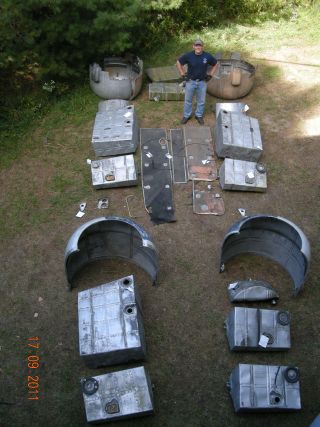
Here are all the parts that Dad and I moved from Kenora.
Removal of Radio Antenna
A serious attempt was made at removing the ‘football’ radio antenna. However, it has been so long since the antenna was removed that the screws that hold it in place have rusted to the anchor nuts.
This means that the screws are going to have be drilled out – but seeing that Dad and I had just completed two days of drilling out rivets (and we were more than a little tired at this point), this tasking is going to have to wait for a while.
Gauging Wire
One of the many problems with putting Expeditor 339 back in the air is that she has to be completely re-wired. Not only is the wire old, but in many cases the wire bundles have been cut right through.
Now, a wire table has been created – which makes things that much easier. (I sat down with all 41 circuits and made a table: one column has the wire number, the next says the wire goes from what component to what component, the next has the length of the wire, the next has the gauge of the wire, the next lists the Wiring Diagram that the wire belongs to, and the last lists page that the wire diagram is found on.)
But, the problem is that the different circuits didn’t list the gauge of the different wires! (Not only that, but as yet I’ve been unable to find a definitive map listing what wire goes exactly where in the airplane.)
So, what I started doing was making very detailed lists as to what wire has been found where and what its gauge is. I'm not saying that the current wire locations are the correct ones, but at least it gives me a starting point with regards to re-wiring.
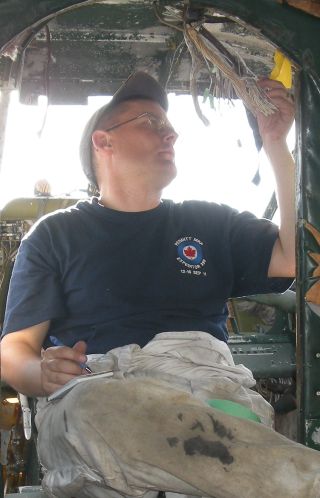
Granted, this is going to take some time to completely identify all 2500+ wires, but it’s something that needs to be done. (And, I feel that it’s better to take the extra effort and do it right the first time.)
Names on Aircraft
It's traditional in the RCAF to have names on the aircraft whenever there is a flight crew and a ground crew assigned to one specific aircraft. Typically, the left side of the aircraft - specifically under the pilot's window - is reserved for the names of the flight crew. And, the right side of the aircraft - specifically under the co-pilot's window - is reserved for the Crew Chief. However, I would like my Maintenance Crew to have the recognition of all the work that they have done and continue to do - so I put their names up in addition to mine. I would like the world to know about how hard they have worked, and how hard they continue to work. And, when the aircraft is flying, I would like the world to see just how proud I am of them and the quality of their work. (Granted the names are written in grease pencil, but this is the location where they will be painted when the project is completed.)
There is one name, though, that I'd like to comment on. Jack Cooper was a good friend of John Hudson, Glen Gibson and myself. (He worked at the Quartermaster Stores - or QM - on Citadel Hill.) Originally, he was a Sergeant in the RCAF, and he served from 1951 to 1979, and he helped me a great deal with the aircraft. He died very recently, and I wanted to honour his contribution to the restoration, his commitment to the RCAF and his memory by putting his name on the aircraft.
Sgt (Ret'd) John Douglas "Jack" Cooper, CD Per Ardua Ad Astra 1929 - 2011 RIP
